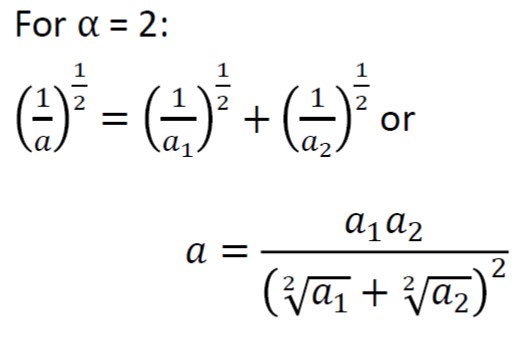Andrey Mokhov spotted that to satisfy the actual inverse Pythagorean we need to have alpha=1/2 rather than 2. That’s right. Indeed, what happens is that if we have alpha = 1/2 we would have (1/a)^2=(1/a1)^2+(1/a2)^2. This is what the inverse Pythagorean requires. In that case, for instance if a1=a2=2, then a must be sqrt(2). So the ratio between the individual decay a1=a2 and the collective decay is sqrt(2). For our stack decay under alpha = 2, we would have for a1=a2=2, a=1/2, so the ratio between individual decay and collective decay is 4.
It’s actually quite interesting to look at these relations a bit deeper, and see how the “Pythagorean” (geometric) relationship evolves as we change alpha from something like alpha<=1/2 to alpha>=2.
If we take alpha going to 2 and above, we have the effect of much slower collective decay than 4x compared to the individual decay. Physically this corresponds to the situation when the delay of an inverter in the ring becomes strongly inversely proportional to voltage. Geometrically, this is like contracting the height of the triangle in which sides go further apart than 90 degrees – say the triangle is isosceles for simplicity, and say its angle is say 100 degrees.
The case of alpha = 1/2 corresponds to the case where delay is proportional to the square root of Voltage, and here the stack makes the decay rate to follow the inverse Pythagorean! So this is the case of a triangle with sides being at 90 degrees.
But if alpha goes below 1/2, we have the effect of the collective decay being closer to individual decays, and geometrically the height of the triangle where sides close up to less than 90 degrees!
Incidentally, Andrey Mokhov suggested we may consider a different physical interpretation for inverse Pythagorean. Instead of looking at lengths a, b and h, one can consider volumes Va, Vb and Vh of 4-D cubes with such side lengths. Then these volumes would relate exactly as in our case of alpha=2, i.e. 1/sqrt (Vh)=1/sqrt(Va)+1/sqrt(Vb).
Cool!

